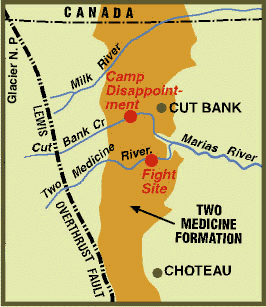Overlooked Dinosaurs
Between the Cordilleran thrust belt—also called the Lewis Overthrust—and the continually shifting western shoreline of the Colorado Sea, which covered much of the interior of present-day North America during the Cretaceous, is a 3,600-square-mile, 2,000-foot-thick layer of non-marine sediments called the Two Medicine Formation. It contains the documentary history of a time span of roughly 12 million years.
Sometime between 144 and 65 million years ago—following the period parodied in the movie, Jurassic Park—this was prime dinosaur habitat, and today it ranks among the world’s most productive fossil-bearing formations. The northern half is especially noteworthy for the nests and bone beds recently found there, which have provided paleontologists with valuable clues relating to dinosaurian nesting habits and herd structure.
During his trip up the Marias in June 1805, had he not been continually on the lookout for signs of those hostile Blackfeet Indians other tribes had warned him about, Lewis just might have seen some fossils of marine shellfish. And on his more extensive trip in 1806, had he not had his gaze fixed on the horizon, watching for presumably hostile Blackfeet Indians, he just might have counted among his discoveries what would come to be known as a duck-billed dinosaur, a Tyrannosaurus rex, or some hypsilophodon eggs.[1]On the other hand, he did manage to pick up six plant specimens, five of them new to science, and carry them on his break-neck ride of 27 and 28 July. They are now part of the collection at the … Continue reading
Thomas Jefferson would have been elated![2]The science of paleontology, new at the time, was one of Jefferson’s favorite subjects. See Donald Jackson, Thomas Jefferson & the Stony Mountains: Exploring the West from Monticello … Continue reading
Overlooked Bison Bones
These bones protruding from the south bank of Cut Bank Creek about 24 inches below ground level possibly indicate the use of the nearby buffalo jump long before Lewis camped here. The Blackfeet Indians generally abandoned that means of killing bison after they acquired horses and developed the “surround”method, sometime before the middle of the 18th century.
Some students of the Expedition believe that since Lewis had ample evidence that Blackfeet Indians had recently been in the area, he would not have camped under that bluff because, with his back to the river, he would have been vulnerable to a surprise attack. It may be that he and the three men with him camped near the creek about a tenth of a mile to the west of the bluff.
In any case, Lewis made no mention of bison remains beneath the cliff, so it is probable that these bones were already covered by river-borne silt.
Further Reading
Robert E. Lange, “Meriwether Lewis’s ‘Camp Disappointment’: Present Day Glacier County, Montana,” We Proceeded On, Vol. 3, No. 1 (February 1977).
Wilbur P. Werner, ” . . . only one smal trout,” We Proceeded On, Vol. 13, No. 4 (November, 1987).
John R. Horner and James Gorman, Digging Dinosaurs (New York: Harper & Row, 1988), 36-49.
Notes
| ↑1 | On the other hand, he did manage to pick up six plant specimens, five of them new to science, and carry them on his break-neck ride of 27 and 28 July. They are now part of the collection at the Academy of Natural Sciences in Philadelphia: Atriplex gardneri (Moq.) D. Dietr, moundscale; Euphorbia marginata Pursh, snow-on-the-mountain; Sphaeralcea coccinea (Nutt.) Rydb., red false mallow; Oenothera cespitosa Nutt. ssp. cespitosa, gumbo evening primrose; Sarcobatus vermiculatus (Hook.) Torr., greasewood. |
|---|---|
| ↑2 | The science of paleontology, new at the time, was one of Jefferson’s favorite subjects. See Donald Jackson, Thomas Jefferson & the Stony Mountains: Exploring the West from Monticello (Norman: University of Oklahoma Press, 1981), 29, 39n. Jackson cites George Gaylord Simpson, “The Beginnings of Vertebrate paleontology in the U.S.” Proceedings of the American Philosophical Society, 86 (1942), 130–88. |
Experience the Lewis and Clark Trail
The Lewis and Clark Trail Experience—our sister site at lewisandclark.travel—connects the world to people and places on the Lewis and Clark Trail.
Discover More
- The Lewis and Clark Expedition: Day by Day by Gary E. Moulton (University of Nebraska Press, 2018). The story in prose, 14 May 1804–23 September 1806.
- The Lewis and Clark Journals: An American Epic of Discovery (abridged) by Gary E. Moulton (University of Nebraska Press, 2003). Selected journal excerpts, 14 May 1804–23 September 1806.
- The Lewis and Clark Journals. by Gary E. Moulton (University of Nebraska Press, 1983–2001). The complete story in 13 volumes.





